Article
Stories in Stone: The Petroglyphs of the West
Author(s):
Petroglyphs are distributed widely across the world and at least three dozen such sites exist in the U.S., all telling the tale of those who lived there thousands of years ago. These places are not easy to find, however and their messages are poorly understood.
Photography by the authors. Rock carvings, petroglyphs, rock paintings and pictographs are distributed widely across the world. At least three dozen such sites exist in the U.S., all telling the tale of those who lived there thousands of years before The Mayflower came to this land.
These places are not easy to find, however, and their messages are poorly understood. It’s almost as if there’s no more than what Persian philosopher Omar Khayyám said, “The moving finger writes and having writ moves on…” The authors of those narratives are no longer around to explain. Perhaps that’s what makes petroglyphs so special.
We don’t have the equivalent of a Rosetta Stone to help our historians interpret the meaning. And present-day native peoples -- who know where those rock texts lie -- regard the sites as so sacred they are not inclined to take travelers there, far less translate their significance.
We came back to Goulding’s Lodge and Campground once from a day in Monument Valley, that magical place that lies like a lost world between Utah and Arizona. We gave an account of our day of adventure to Gerald La Font, who then with his brother owned the lodge. Goulding’s was built in 1923 by Harry Goulding and his wife “Mike.” They went to Hollywood in 1938, on their own initiative, knowing no one and with only $60 in their pockets to talk John Ford into considering their beloved valley as the location for his new western, “Stagecoach.” The rest, as the cliché goes, is history.

We told La Font we’d taken some photographs of petroglyphs in Monument Valley's Navajo Tribal Park, now part of the Navajo Nation Reservation. He was surprised and asked how we managed that. We explained we were traveling in the Jeep tour he’d arranged for us with a Navajo guide when we suddenly shouted, “Stop, please!” The guide turned around with an inscrutable face and said nothing. We pointed at a rock face and a marvelous piece of rock art. We held up a camera and asked if we could get out and take a photograph. He nodded. We took some photographs and the tour continued farther into the Navajo “Valley of the Rocks.”
La Font explained that if we had asked our guide upfront to take us to see some petroglyphs to photograph, he would have claimed not to understand you.
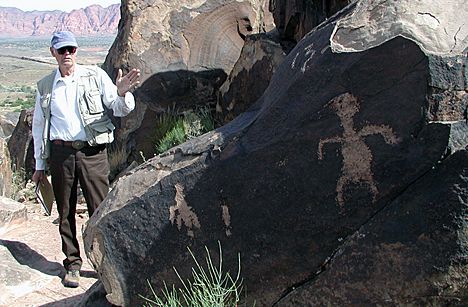
We were even more lucky in Utah in Snow Canyon State Park, where the Anasazi (or as the Hopi now prefer, the Hisatsinom) lived till about 1200 AD when the Paiute Indians appeared on the scene. We had a guide, Boma Johnson, whose skill was leading guests into both the desert and the distant past. With a Masters in Native American studies and in archaeology he had earned the trust of local tribes with his sensitivity to Indian spirituality. (“It's OK to call them Indians,” he says, "that's what they call themselves.”)
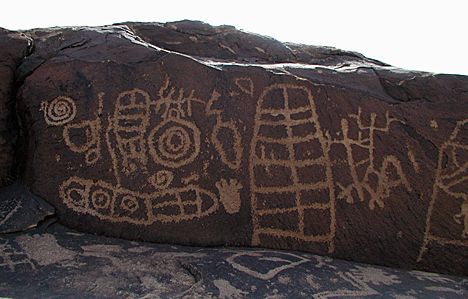
Johnson points out rocks that show the dense black "desert varnish" of manganese and iron oxide. Chiseled by stones out of the varnish many centuries ago are the petroglyphs, what Johnson called “story panels sharing information with viewers in attempts to communicate.”
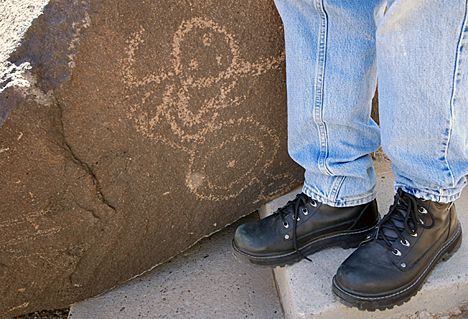
When you get to Petroglyph National Monument about a half hour drive west of Albuquerque, N.M., you realize the value of a guide. The small visitor center was once the home of anthropologist Dr. Sophie Aberle, who did much as an administrator for Indian Affairs to improve the life and health of the women living in the pueblos of New Mexico. She had a PhD from Stanford and a medical degree from Yale, and was an early proponent of computer use in pueblo school classrooms.
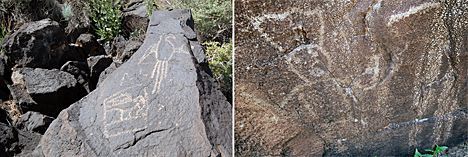
Even at a national monument named for its rock art, the petroglyphs prove hard to find with the small map provided. At the time of our visit, the area did not seem to be signed well but perhaps anything worth having is worth the time spent looking for it. Or maybe life is easier with a personal guide. Titus Canyon in Death Valley, Calif., makes it easier. It posts a sign in front of a massive rock face populated by ancient graffiti.
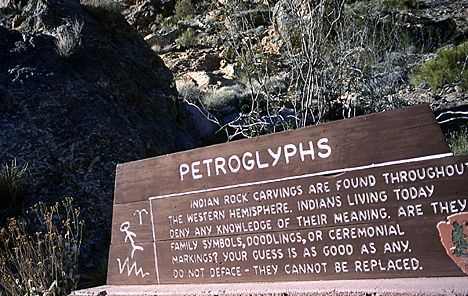
Mesa Verde National Park in Colorado has a more hospitable greeting for visitors. The inland sea that covered the land about 100 million years ago took its time to recede, but the red dust that blew from the southwest was rich in minerals and perfect for growing corn. The Anasazi lived here until around the year 1400. The Cliff Palace has pictographs that help tell visitors their story. We ask the Hopi docent what one specific piece of rock art in a window is saying; she smiles and says, “You have to listen closely to those stones and if you do, many of our mysteries will be revealed.”

If you want answers about rock art, plan a trip to Phoenix and sign up for a Hummer tour of the desert with, for example, Steve Andeasen’s Roadrunner Desert Adventures. That’s the hat of our guide on top of a petroglyph in the desert. A few moments before he had stopped us on a path while he removed a rattlesnake from our feet with his special pole.
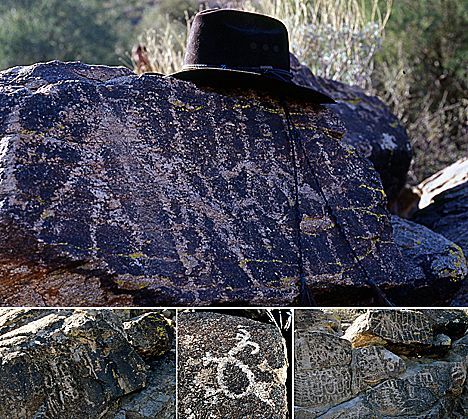
You can get out into the desert from Tucson as well. Just be sure and tell your tour operator that you want to see petroglyphs. Don’t expect much in the way of explanations of what the rock art is saying. Even tribal elders seem perplexed by the meaning of the drawings.

One of the most attractive petroglyphs we’ve seen was also, paradoxically, the easiest to find. We were on a jetboat on the Snake River in Hells Canyon in Idaho. Hells Canyon Tours had been on the river since 1974 and we had mentioned to the guide that we hoped to see some petroglyphs.
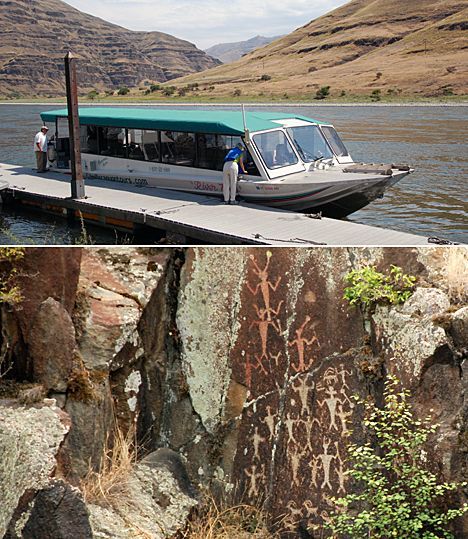
A couple of hours later our guide cut the engine and as we drifted into the river bank, there they were: Rather beautiful figures many centuries old. What did they show? A battle, a tribal history, a great hunt? Certainly a story.
Some stories come easier to the viewer. Never more obvious than in Kansas at Pawnee Rock, where legible names are cut into the relatively soft Dakota Sandstone rock face that overlooks the Santa Fe Trail.
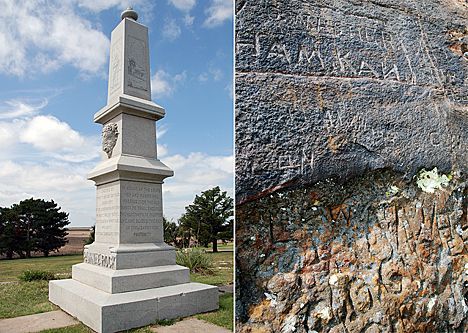
Legends say various tribes of Pawnee Indians met on top of the rock in general council, the name was supposedly given to the landmark after Kit Carson took part in a skirmish with Indians there. Originally 150 feet high, it was a landmark for wagon trains and many pioneers carved their initials to show they had at least reached this point on the trail.
The Andersons, who live in San Diego, are the resident travel & cruise columnists for Physician's Money Digest. Nancy is a former nursing educator, Eric a retired MD. The one-time president of the New Hampshire Academy of Family Practice, Eric is the only physician in the American Society of Travel Writers. He has also written five books, the last called The Man Who Cried Orange: Stories from a Doctor's Life.




